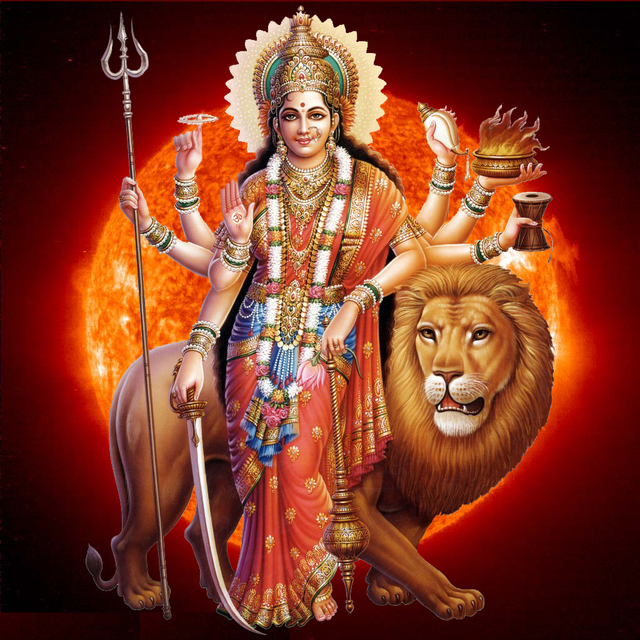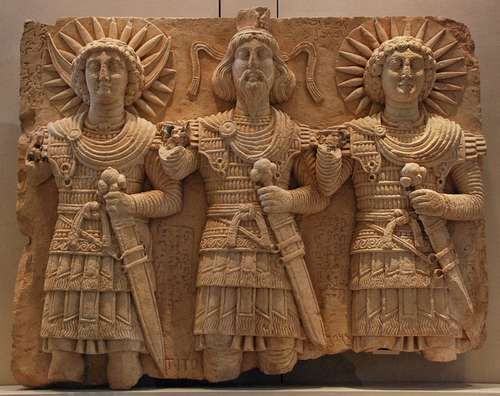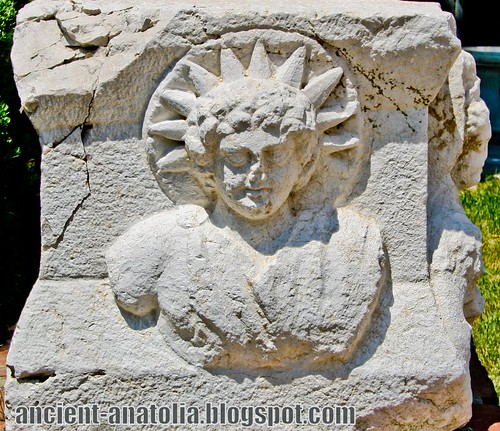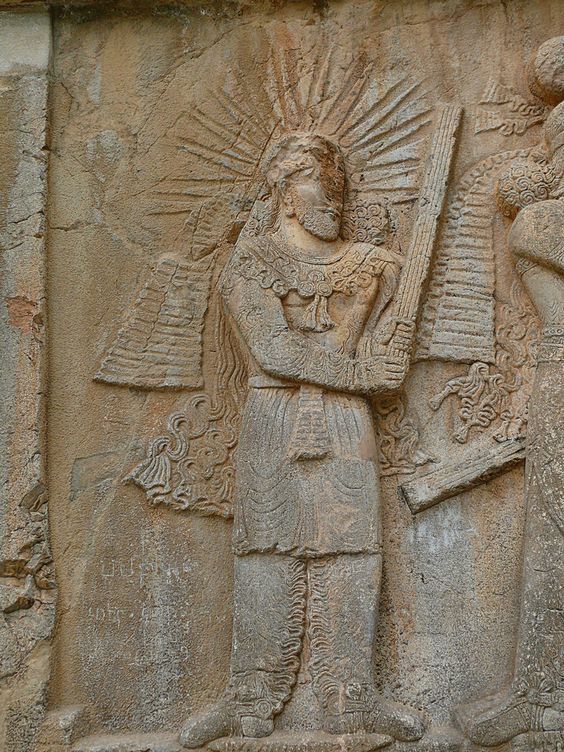
| SUN SYMBOL 16. Sun Symbol :
Sun Symbol is used in background of many Gods and Goddesses in India. Here, again we can find similarities in civilizations when we carefully look at images and statues.
Goddess Gayatri with Sun behind head along with Swan and Lotus The son of Angiras (Ali) named Ucathya (Alf) was of the wolf tribe, the Seafarer Wolves and the Seafarers were Swans the Red hence, we see Swan as Symbol of Sons of Angiras / Ali and Lotus also represents Sun. She is seated with Bandudu / Kamandal.
Goddess Gayatri represents Sun and we can see Sun drawn behind her head. Here, we can see the infulence of chaldean matriarchist cult which was later added into Aryans culture by the chaldean Brahmins.
Goddess Durga / Parvati Goddess Durga / Parvati / Inanna / Eve was the wife of Indra / Gis'zax (Caxus) / Adam / Thor / Sag / Zag she is shown with Aryan symbols such as Fire, Damru, Trident and Sun behind her head representing Sun worshipper Aryans.
To know more about Damru Click here.
Lord Ram Lord Ram was of Angiras lineage of Aryan Sun worshippers and hence we can see Sun behind his head.
Limestone relief from Palmyra (Syria) showing the Moon God Aglibol, the Supreme God Baalshamin, and the Sun God Malakbel (from left to right). First half of the first century CE. Exhibited in the Louvre Museum, Paris Here, we find Moon God Aglibol with Sun and Crescent Moon in background and Sun God Malakbel with Sun behind his head.
Mithra Relief Here, from Mithra Relief, (Mithras are Aryans) we can see the Gothic Cap of Aryans and Sun. We can also find Snake and Crescent Moon of chaldean matriarchist cult.
Sol Invictus of Antioch of Pisidia at Archaeology Museum of Yalvac near Konya, Turkey Sol Invictus ("Unconquered Sun") was the Roman state-supported sun god created by the emperor Aurelian in 274 and continued, overshadowing other Eastern cults in importance, until the abolition of paganism under Theodosius I. By far the earliest appearance of an inscription linking the unconquered emperor with the sun is the legend on a bronze phalera dated by its style to the second century, in the Vatican collections: Inventori Lucis Soli Invicto Augusto.
The Romans held a festival on December 25 of Dies Natalis Solis Invicti, "the birthday of the unconquered sun." December 25 was the date after the winter solstice, with the first detectable lengthening of daylight hours. There was also a festival on December 19.
The title Sol Invictus had also been applied to a number of other solar deities before and during this period. The type of Sol Invictus, though not the name, appears on imperial coinage from the time of Septimius Severus onwards. A solidus of Constantine as well as a gold medallion from his reign depict the Emperor's bust in profile twinned ("jugate") with Sol Invictus, with the legend Invictus Constantinus.
Though many Oriental cults were practiced informally among the Roman legions from the mid-second century, only that of Sol Invictus was officially accepted and prescribed for the army.
God Mithra on the rock relief of Shapour II at Taq-e Bustan According to Lieutenant Colonel Laurence Austine Waddell :
The Makers of Civilization in Race and History :
FIG.
11 : Phoenician worship of the Sun-god.
From a Phoenician stele (or altar) of about fourth century B.C.
(After
Renan, Mission de Phenicie. pl. 32)
Note
: The rayed halo of the Sun-god
St. Michael the Patron Saint of the Sumerian first "Phoenician" Dynasty in Mesopotamia also the Patron Saint of the European Phoenicians :
In
religion also, it was shown that the Phoenicians, even in their
late period in the Mediterranean were essentially Sun-worshippers
(a wholly non-Semitic cult), like the Sumerians or Early Aryans.
Thus see Fig. 11 for a Phoenician stele or altar to the Sun-god-the
Sun-god being latterly represented by the Sumerians in human fonn
as a reflex of their deified first king Dar or Tur (Thor of the
Eddas) who established Sun-worship as part of his system of Civilization.
FIG. 12 : St Michael, the Archangel, or "Lord Mukhla" of the Sumerians, on Phoenician coins of Cilicia of the fifth century B.C. (After Hill, see WPOB. 349 for details). Compare with Ancient Briton forms in Fig. 13 The son of Angiras (Ali) named Ucathya (Alf) was of the wolf tribe, the Seafarer Wolves and the Seafarers were Swans the Red hence, we see Swan as Symbol of Sons of Angiras / Ali and Lotus also represents Sun. St Michael is Daksh, Bakus, Bacchus or Dionysos. |








